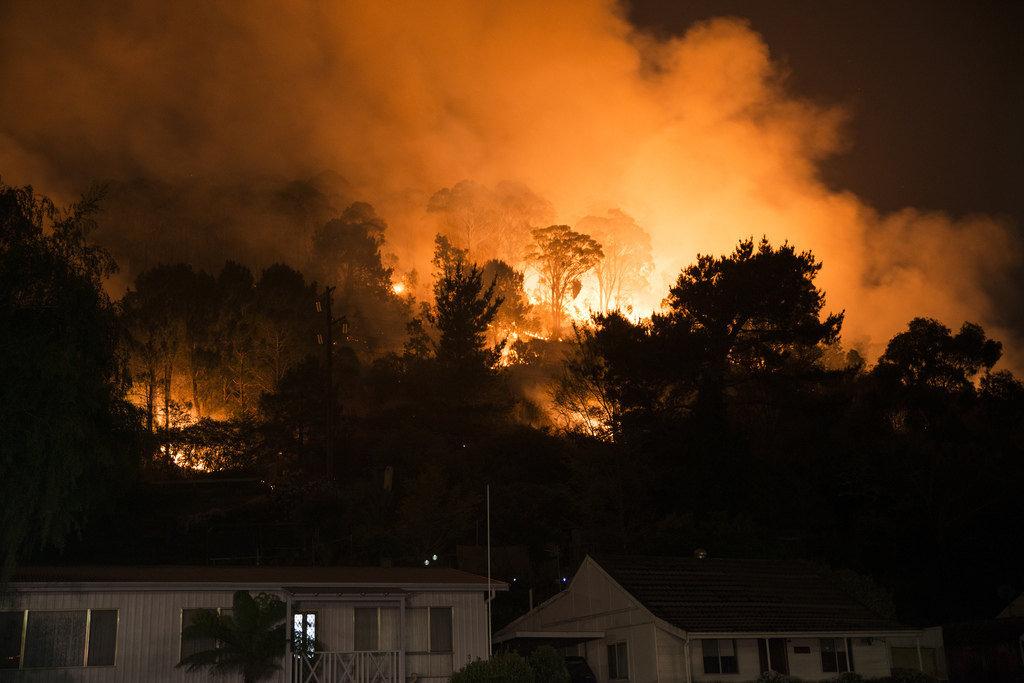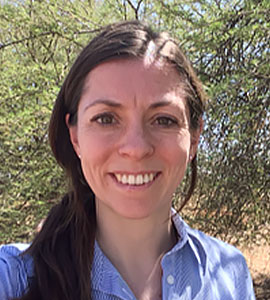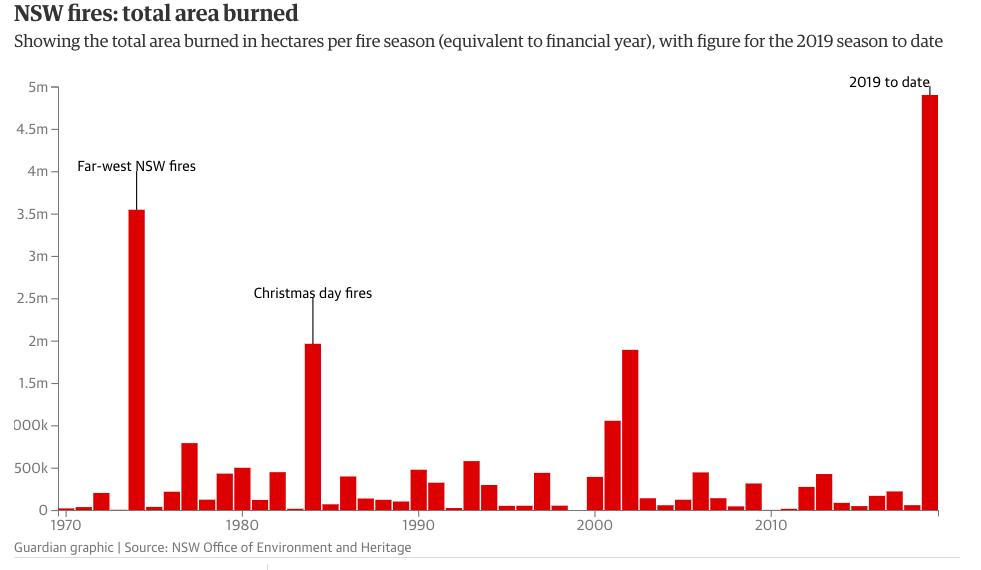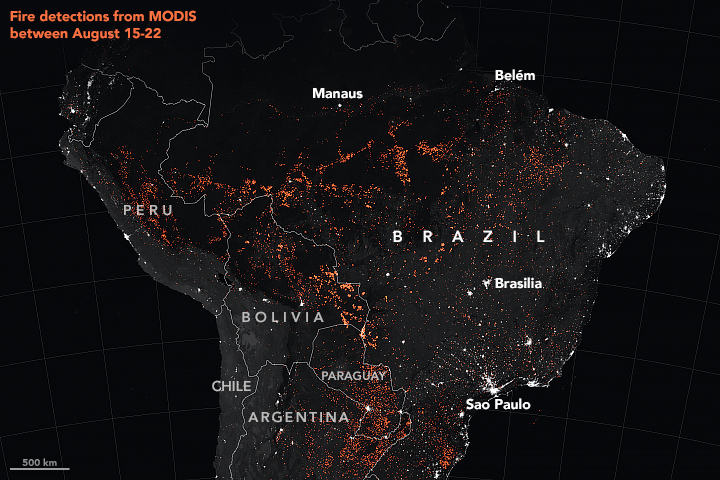While the area burnt by wildfires has declined globally over the past decades, fire is now occurring more frequently and severely in ecosystems that have historically rarely experienced fire. This issue brief examines the cause and sustainability implications of global fires.
In the News
Since September 2019, bushfires across Australia have burnt over 11 million hectares of land, killed 33 people, destroyed more than 2000 homes and displaced thousands of people1. The full impact on wildlife is still to be determined.
Why does this matter?
As some fires continue to burn in parts of Australia (see Box 1), many communities and ecosystems around the world are still recovering from an extreme wildfire season. For example, in 2019, wildfires raged across large areas of Canada, Siberia, the Mediterranean, and the Amazon (see Box 2), bringing into focus the devastating power and potential threat of fire across the world. Globally, the area burnt by wildfires has declined over the past decades2 by up to 25%3. However, the regions experiencing fire are shifting4. While fire can be important for maintaining ecosystems processes and vegetation in some ecosystems, e.g. savannahs and grasslands5, it is now occurring more frequently in ecosystems that rarely experience large fires (e.g. tropical forests). An increase in the frequency and intensity of wildfires6,7,8, especially in ecosystems that are not adapted to fire, could lead to lasting changes in vegetation structure and composition 9,10, wildlife populations11,12, soil erosion13 and the benefits humans derive from these landscapes14.
Drivers of change
These changes in patterns of, and increasing susceptibility to, fires are attributed to two main and interacting factors: climate change-driven changes in extremes7,15, widespread land use change16,17,3, including and especially increasing anthropogenic ignitions18,19. When combined, these factors can create ideal conditions for rapidly spreading and intense fires that are difficult to extinguish. Such wildfires have become increasingly common in some parts of the world – California (2017, 2018), Canada (2014, 2017, 2018), the Mediterranean (2017, 2018), Siberia (2003, 2012, 2019), Australia (2009, 2013, 2019) – impacting the health of local economies, ecosystems, and people.
For millennia, humans have used fire in landscapes to clear vegetation, improve grazing and hunting and manage nutrient cycles20. Today a combination of fire suppression policies, shifts towards permanent agricultural practices, and human settlement patterns are changing long-term trends in fire18. Savannahs, grasslands and dry forests which used to burn annually are burning less due to permanent crops and livestock that reduce fuel loads and fire suppression to protect valuable crops and properties. In contrast, tropical and boreal forests have seen a rise as people use fire to clear space for new agriculture. Where and when fires will occur will depend on future climatic and land use changes, with large differences and uncertainties across regions21, and therefore are not easy to accurately predict. However, globally, the pattern22 and incidence7 of wildfires is expected to continue to change with climate change, particularly in the northern hemisphere where the fire season could lengthen by 20 days by 21007. Additional insights on the impact of fire in a future warmer world can be gained by considering past climate changes, including periods when fire regimes were under more “natural conditions” and human influence on fire regimes was less relevant.
Box 1. Australian Bushfires
Although much of the Australian landscape is a fire-dependent savannah ecosystem23, the frequency of bushfires increased by 40% between 2007 and 20138. Fires are precipitated by hot, dry and windy conditions which increase fuel loads and spread flames quickly once fire ignites. In Australia, these weather patterns are strongly associated with the El Niño Southern Oscillation (ENSO) and are exacerbated when there is a positive Indian Ocean Dipole (IOD), especially in the south east parts of the continent which causes low spring rainfall24. A record-breaking drought through 2018 tied to an ENSO and IOD and hotter than average temperature left much of Australia’s ecosystems highly vulnerable to the subsequent fires in 201925. According to Dr. David Bowman, director of the Fire Center at the University of Tasmania, what makes the fires in 2019 different from other years is their geographic extent across Australia, burning ecosystems that do not usually burn (e.g. rainforest, wet eucalypt forests and banana plantations) and the fact that they are all happening at once26. This led to a record-breaking 11 million hectares of land burnt.
The total area burned in hectares per fire season in New South Wales Australia (equivalent to financial year), with figure for the 2019 season to 24 Dec 2019. Source: The Guardian based on data from NSW Office of Environment and Heritage

Fire on the hills to the north of Lithgow (New South Wales) during the October 2013 bushfires. Source: Wikimedia Commons
Box 2. Amazon fires and ecosystem tipping points
The Amazon saw a significant uptick in the number of fires across Brazil, Bolivia and Peru (with ~9000 km2 burnt) in 2019 due to human-driven deforestation, logging and exploitation. This in itself is a cause for concern as there are fears that the interaction of deforestation, widespread use of fire for clearing and climate change are pushing this normally wet tropical ecosystem closer to an ecological tipping point, towards a degraded low-carbon savannah system10. This is important for global sustainability as the Amazon forest is the world’s largest carbon sink, but whose capture and storage of carbon dioxide has been decreasing over the past decades27.
What are the implications for our path towards sustainability?
As the conditions that lead to fires are changing with climate and human land use patterns, new landscapes for severe fire regimes are being created with ecological, social, and economic repercussions.
- Ecological impacts: Fire plays an essential role in ecosystems – maintaining savannahs and creating mosaic habitats in temperate and boreal systems. Depending on their frequency and severity, fires have important impacts on ecosystems. For example, fires can have a positive feedback cycle in tropical forests by opening and drying out normally closed-canopy forests, making them more susceptible to future fire28,29. Clearing large areas of forests can lower local precipitation amounts by reducing evapotranspiration from the canopy and lead to shifts in vegetation towards more fire prone communities10. Forests and other ecosystems also store large quantities of carbon in their biomass and soils. Global fires were estimated to have released 8.1 Peta grams of CO2-equivalents per year between 1997-201630 or about 23% of global fossil fuel CO2 emissions in 201430. As we move beyond the natural fire regime of many ecosystems, we do not yet fully understand how these systems will evolve and thus how best to manage them.
- Economic impacts: Fires come at a huge financial cost. For example, the total annual cost of 2005 bushfires in Australia was estimated at $12 billion, an amount equivalent to 1.3% of Australia’s GDP31. In California, another region struggling with worsening forest fires estimates the 2017 and 2018 wildfire seasons together cost over $40 billion32. The ‘Camp Fire’ in 2018 alone cost $15 billion as it burnt through 8.7 million acres of land, scorched 18,500 structures, and killed 88 people. These economic costs are mounting in many regions as urban infrastructure continues to expand into fire prone areas, increasing both the likelihood of anthropogenic ignitions and the loss of property when it does occur. A number of industries can also be impacted inflicting further economic losses. For instance wine-producers in Australia are forsaking their vintage this year as their crops were damaged by smoke33. These and other costs are expected to continue to increase as fires become more frequent and difficult to extinguish.
- Social impacts: Fire has long-standing social implications. Historically, communities have relied on controlled fires to restore soil fertility, encourage new biomass growth for livestock, and maintain cultural landscapes and sites of cultural importance 34,35. However, widespread and extreme fires pose direct and indirect threats to human health and life. Increasing urban expansion into high-risk fire corridors increases exposure of life and property to fire36. Globally fire emissions are also responsible for 5-8% of the 3.3 million premature deaths each year from poor air quality37 and the contamination of drinking water in affected watershed from ash runoff38. The social and health impacts are often longer lasting than the fire itself, with a rise in mental health problems for people experiencing wildfires and other natural disasters39.
What are the pathways forward to manage fire sustainably?
As global temperatures continue to rise, our changing climate will inevitably lead to more severe and intense wildfires in most ecosystems40. To reduce the negative impacts associated with wildfires, controlled fires are increasingly used in many fire-prone areas to reduce fuel loads and lessen the intensity of subsequent fires. As well, traditional knowledge of fire use by local and indigenous communities can provide information on culturally and environmentally sustainable fire management practices to improve biodiversity and local livelihoods. However, as fire regimes shift across the world, communities with little previous exposure to fire will need to quickly adapt and adopt fire management policies. Sharing and combining diverse forms of knowledge (long-term ecological data and traditional knowledge) from places with a long-term history of fire can help to identify solutions and support decisions on new fire policy in areas that will be most affected by future climatic and land-use changes. To do this, new stakeholder groups that include scientists, park managers, citizens and policy makers will need to come together to develop fire policy for the twenty-first century.
For additional recommendations on future fire management policies and strategies, please consult the policy brief here co-developed and co-funded by Past Global Changes (PAGES), a Future Earth Global Research Project.
Produced in collaboration with
Dr. Daniele Colombaroli, Royal Holloway University of London, Centre for Quaternary Research (CQR), Department of Geography London UK, Past Global Changes – Global Research Project
Dr. Sophie C. Lewis, University of New South Wales, Canberra, ACT, Australia
And Future Earth Australia
References
[1] BBC, 2020. Australia fires: A visual guide to the bushfire crisis. The British Broadcasting Corporation. Online Jan 31st 2020, Accessed Feb 7th 2020 at: https://www.bbc.com/news/world-australia-50951043
[2] Andela, N., Morton, D.C., Giglio, L., Chen, Y., Van Der Werf, G.R., Kasibhatla, P.S., DeFries, R.S., Collatz, G.J., Hantson, S., Kloster, S. and Bachelet, D., 2017. A human-driven decline in global burned area. Science, 356(6345), pp.1356-1362.
[3] Doerr, S.H. and Santín, C., 2016. Global trends in wildfire and its impacts: perceptions versus realities in a changing world. Philosophical Transactions of the Royal Society B: Biological Sciences, 371(1696), p.20150345.
[4] Giglio, L., Randerson, J.T. and van der Werf, G.R., 2013. Analysis of daily, monthly, and annual burned area using the fourth‐generation global fire emissions database (GFED4). Journal of Geophysical Research: Biogeosciences, 118(1), pp.317-328.
[5] Scholes, R.J. and Archer, S.R., 1997. Tree-grass interactions in savannas. Annual review of Ecology and Systematics, 28(1), pp.517-544.
[6] Westerling, A.L., Hidalgo, H.G., Cayan, D.R. and Swetnam, T.W., 2006. Warming and earlier spring increase western US forest wildfire activity. Science, 313(5789), pp.940-943.
[7] Flannigan, M., Cantin, A.S., De Groot, W.J., Wotton, M., Newbery, A. and Gowman, L.M., 2013. Global wildland fire season severity in the 21st century. Forest Ecology and Management, 294, pp.54-61.
[8] Dutta, R., Das, A. and Aryal, J., 2016. Big data integration shows Australian bush-fire frequency is increasing significantly. Royal Society Open Science, 3(2), p.150241.
[9] Cochrane, M.A. and Schulze, M.D., 1999. Fire as a Recurrent Event in Tropical Forests of the Eastern Amazon: Effects on Forest Structure, Biomass, and Species Composition 1. Biotropica, 31(1), pp.2-16.
[10] Lovejoy, T.E. and Nobre, C., 2018. Amazon tipping point. Science Advances, Vol. 4, no. 2, eaat2340.
[11] Barlow, J. and Peres, C.A., 2004. Avifaunal responses to single and recurrent wildfires in Amazonian forests. Ecological Applications, 14(5), pp.1358-1373.
[12] Kennedy, P.L. and Fontaine, J.B., 2009. Synthesis of knowledge on the effects of fire and fire surrogates on wildlife in US dry forests. Oregon State University Agricultural Extension Station.
[13] Pierce, J.L., Meyer, G.A. and Jull, A.T., 2004. Fire-induced erosion and millennial-scale climate change in northern ponderosa pine forests. Nature, 432(7013), pp.87-90.
[14] Turner, M.G., Donato, D.C. and Romme, W.H., 2013. Consequences of spatial heterogeneity for ecosystem services in changing forest landscapes: priorities for future research. Landscape ecology, 28(6), pp.1081-1097.
[15] Jolly, W.M., Cochrane, M.A., Freeborn, P.H., Holden, Z.A., Brown, T.J., Williamson, G.J. and Bowman, D.M., 2015. Climate-induced variations in global wildfire danger from 1979 to 2013. Nature Communications, 6(1), pp.1-11.
[16] Aragao, L.E.O., Malhi, Y., Barbier, N., Lima, A., Shimabukuro, Y., Anderson, L. and Saatchi, S., 2008. Interactions between rainfall, deforestation and fires during recent years in the Brazilian Amazonia. Philosophical Transactions of the Royal Society B: Biological Sciences, 363(1498), pp.1779-1785.
[17] Archibald, S., Roy, D.P., van Wilgen, B.W. and Scholes, R.J., 2009. What limits fire? An examination of drivers of burnt area in Southern Africa. Global Change Biology, 15(3), pp.613-630.
[18] Bistinas, I., Harrison, S.P., Prentice, I.C. and Pereira, J.M.C., 2014. Causal relationships vs. emergent patterns in the global controls of fire frequency. Biogeosciences, 11, pp.5087-5101.
[19] Clarke, H., Gibson, R., Cirulis, B., Bradstock, R.A. and Penman, T.D., 2019. Developing and testing models of the drivers of anthropogenic and lightning-caused wildfire ignitions in south-eastern Australia. Journal of Environmental Management, 235, pp.34-41.
[20] Bowman, D.M., Balch, J., Artaxo, P., Bond, W.J., Cochrane, M.A., D’antonio, C.M., DeFries, R., Johnston, F.H., Keeley, J.E., Krawchuk, M.A. and Kull, C.A., 2011. The human dimension of fire regimes on Earth. Journal of Biogeography, 38(12), pp.2223-2236.
[21] Gia, G. and Shevliakova, E., 2019. Chapter 2: Land-Climate interactions. In Special Report on Climate Change and Land. Intergovernmental Panel on Climate Change.
[22] Krawchuk, M.A., Moritz, M.A., Parisien, M.A., Van Dorn, J. and Hayhoe, K., 2009. Global pyrogeography: the current and future distribution of wildfire. PloS one, 4(4).
[23] Crisp, M.D., Burrows, G.E., Cook, L.G., Thornhill, A.H. and Bowman, D.M., 2011. Flammable biomes dominated by eucalypts originated at the Cretaceous–Palaeogene boundary. Nature Communications, 2(1), pp.1-8.
[24] Harris, S. and Lucas, C., 2019. Understanding the variability of Australian fire weather between 1973 and 2017. PLoS one, 14(9), p.e0222328.
[25] Tobin, S., Ganter C., and Duell. R., 2018. Australia moves to El Niño alert and the drought is likely to continue. The Conversation, Online October 9, 2018. Accessed February 15th 2020, at: https://theconversation.com/australia-moves-to-el-nino-alert-and-the-drought-is-likely-to-continue-104636
[26] Morton, A., 2019. Yes, Australia has always had bushfires: but 2019 is like nothing we’ve seen before. The Guardian, Online, December 24, 2019. Accessed February 15th 2020, at: https://www.theguardian.com/australia-news/2019/dec/25/factcheck-why-australias-monster-2019-bushfires-are-unprecedented
[27] Brienen, R.J., Phillips, O.L., Feldpausch, T.R., Gloor, E., Baker, T.R., Lloyd, J., Lopez-Gonzalez, G., Monteagudo-Mendoza, A., Malhi, Y., Lewis, S.L. and Martinez, R.V., 2015. Long-term decline of the Amazon carbon sink. Nature, 519(7543), pp.344-348.
[28] Laurance, W.F., 2004. Forest-climate interactions in fragmented tropical landscapes. Philosophical Transactions of the Royal Society of London. Series B: Biological Sciences, 359(1443), pp.345-352.
[29] Cochrane, M.A., 2003. Fire science for rainforests. Nature, 421(6926), pp.913-919.
[30] Van Der Werf, G.R., Randerson, J.T., Giglio, L., Van Leeuwen, T.T., Chen, Y., Rogers, B.M., Mu, M., Van Marle, M.J., Morton, D.C., Collatz, G.J. and Yokelson, R.J., 2017. Global fire emissions estimates during 1997-2016. Earth System Science Data, 9(2), pp.697-720.
[31] Ashe, B., McAneney, K.J. and Pitman, A.J., 2009. Total cost of fire in Australia. Journal of Risk Research, 12(2), pp.121-136.
[32] NOAA National Centers for Environmental Information (NCEI) U.S. Billion-Dollar Weather and Climate Disasters (2020). https://www.ncdc.noaa.gov/billions/
[33] Kurmelovs, R., 2020. No vintage: Australian vineyards dump grape harvest as bushfire smoke takes its toll. The Guardian. Online February 7, 2020. Accessed February 15, 2020, at: https://www.theguardian.com/australia-news/2020/feb/07/no-vintage-australian-vineyards-dump-grape-harvest-as-bushfire-smoke-takes-its-toll
[34] Mistry, J., Berardi, A., Andrade, V., Krahô, T., Krahô, P. and Leonardos, O., 2005. Indigenous fire management in the cerrado of Brazil: the case of the Krahô of Tocantíns. Human Ecology, 33(3), pp.365-386.
[35] Mistry, J., Bilbao, B.A. and Berardi, A., 2016. Community owned solutions for fire management in tropical ecosystems: case studies from Indigenous communities of South America. Philosophical Transactions of the Royal Society B: Biological Sciences, 371(1696), p.20150174.
[36] Hammer, R.B., Radeloff, V.C., Fried, J.S. and Stewart, S.I., 2007. Wildland–urban interface housing growth during the 1990s in California, Oregon, and Washington. International Journal of Wildland Fire, 16(3), pp.255-265.
[37] Lelieveld, J., Evans, J.S., Fnais, M., Giannadaki, D. and Pozzer, A., 2015. The contribution of outdoor air pollution sources to premature mortality on a global scale. Nature, 525(7569), pp.367-371.
[38] Smith, H.G., Sheridan, G.J., Lane, P.N., Nyman, P. and Haydon, S., 2011. Wildfire effects on water quality in forest catchments: a review with implications for water supply. Journal of Hydrology, 396(1-2), pp.170-192.
[39] Simpson, D.M., Weissbecker, I. and Sephton, S.E., 2011. Extreme weather-related events: Implications for mental health and well-being. In Climate change and human well-being (pp. 57-78). Springer, New York, NY.
[40] Colombaroli D, Mistry J, Milner A, Vannière B, Adolf C, Bilbao BA, Carcaillet C, Connor S, Daniau AL, Hawthorne D, Jeffers E, Larson E, Petrokofsky G, Power MJ, Sinnadurai P, Berrio JC, Cassino R, Gildeeva O, Grosvenor M, Hardiman M, Hennebelle A, Kuosmanen N, Lestienne M, Portes MC, Rockell G, Tsakiridou M, Walsh A (2019). Diverse knowledge informing fire policy and biodiversity conservation. Policy Brief. Royal Holloway University of London, UK.





